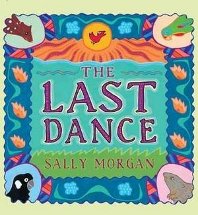The last dance by Sally Morgan

Little Hare, 2012. ISBN 978 1 921714 84 9.
Warmly recommended. Picture book. Environment. On each double page
spread, an Australian creature is presented, telling the reader in a
short, pithy Haiku of the animal and its fate. Bordering the double
pages are pictures of each animal and the central panel contains the
poem, the animal and its environment all rendered in the strong lined,
highly coloured, decorative illustrations we resognise instantly as
Aboriginal Art. And with Sally Morgan as the author illustrator,
we know we are in for a treat.
The Haiku tell in a brief few lines something about the creature. So we
have the Flatback Turtle, for example,
'Covered by slick oil
He swims
Searching for clear ocean.'
In so few lines we see the animal degraded by pollution, swimming
almost helplessly against the probability that his ocean will be always
polluted, searching for a clear patch in which to live. The pictures
show the animal dismayed at the rubbish seen in his once pristine
ocean, trying swimming through it. Similarly, the Swift Parrot searches
the clear blue sky for his blue gum nectar once available but now
almost destroyed by land clearance. And on it goes, each double page
presents the creature and the reason it is endangered, dancing its last
dance.
Each of the ten creatures is reiterated at the end of the book, where a
small outline of their habitat is given and what is making its life
difficult. These include the Corroboree Frog, Carnaby's Black Cockatoo,
Spotted-tailed Quoll, Gilbert's Potoroo, Broad-headed Snake, Numbat,
Flatback Turtle, Swift Parrot, Yellow-snouted Gecko, and the Dugong.
A whole range of things which have had an impact upon these animals are
given in the Haiku: fire, fishermen, drought, destruction of habitat,
pollution and introduced species. Each could initiate discussion about
these animals in the classroom and what has hampered their survival in
Australia, as well as providing a list of endangered species to further
research. This beautifully produced book will service the classroom
well, particularly with the greater emphasis on sustainability promoted
in the new curriculum, while work on Aboriginal Art and Haiku will be
greatly enhanced.
Fran Knight